Hydrofoiling is an exciting water sport where a wing-like foil beneath your board lifts you above the water, allowing for faster, smoother rides. Unlike traditional surfing, it offers better speed and maneuverability, opening up new wave-riding possibilities. To get started, you need the right gear, basic skills like balancing and controlling your speed, and safe water conditions. Keep exploring the essentials, and you’ll soon master the tech and techniques to elevate your ride.
Key Takeaways
- Hydrofoiling involves a wing-like structure beneath the board that lifts you above water for smoother, faster rides.
- It offers increased speed, maneuverability, and the ability to ride smaller waves compared to traditional surfing.
- Essential skills include balancing, controlling speed, and mastering smooth turns and pop-ups.
- Safety gear like wetsuits, helmets, and leashes are crucial for safe hydrofoil surfing.
- Practice in calm, shallow waters with minimal crowds helps build confidence and refine hydrofoiling techniques.
What Is Hydrofoiling and How Does It Work?
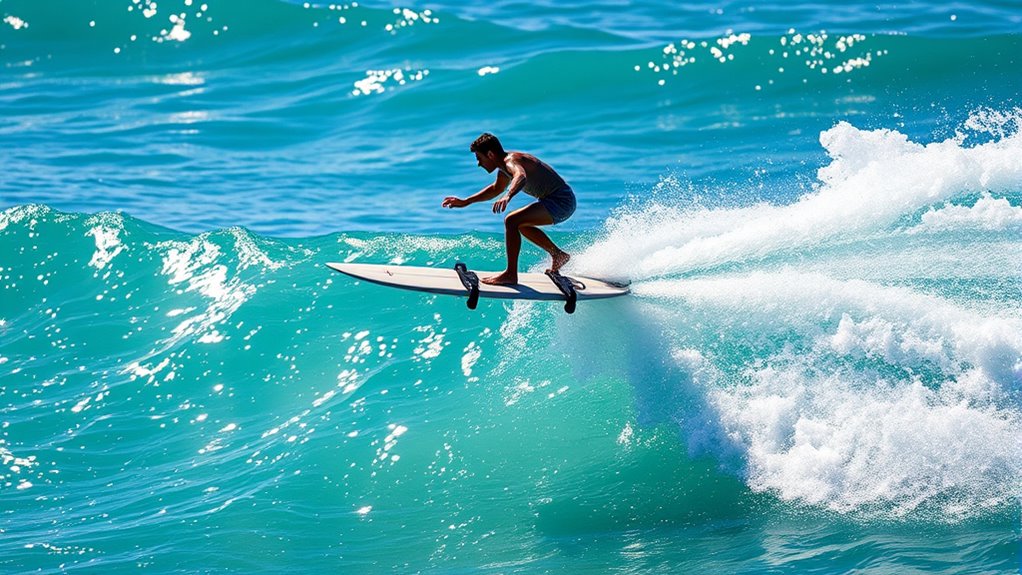
Have you ever wondered how hydrofoiling lifts a surfboard above the water’s surface? It all comes down to the hydrofoil—a wing-like structure attached underneath your board. When you gain speed, the hydrofoil generates lift, just like an airplane wing, pushing the board upward. This reduces drag, allowing you to glide smoothly above the water instead of plowing through it. The key components are the mast, which connects the board to the wing, and the wing itself, which creates lift when water flows over it. As you accelerate, the foil’s shape and angle generate enough lift to raise the board, giving you a feeling of flying. Hydrofoiling combines physics and engineering to transform how you surf, making rides faster, smoother, and more exciting. Understanding hydrofoil design can help you appreciate the engineering behind these innovative watercrafts. Additionally, mastering hydrofoil stability is essential for a smooth and safe experience on the water. Proper hydrodynamic principles are fundamental to optimizing foil performance and ride quality. Enhancing your knowledge of aerodynamic lift can also improve your control and confidence while riding.
Comparing Hydrofoiling to Traditional Surfing
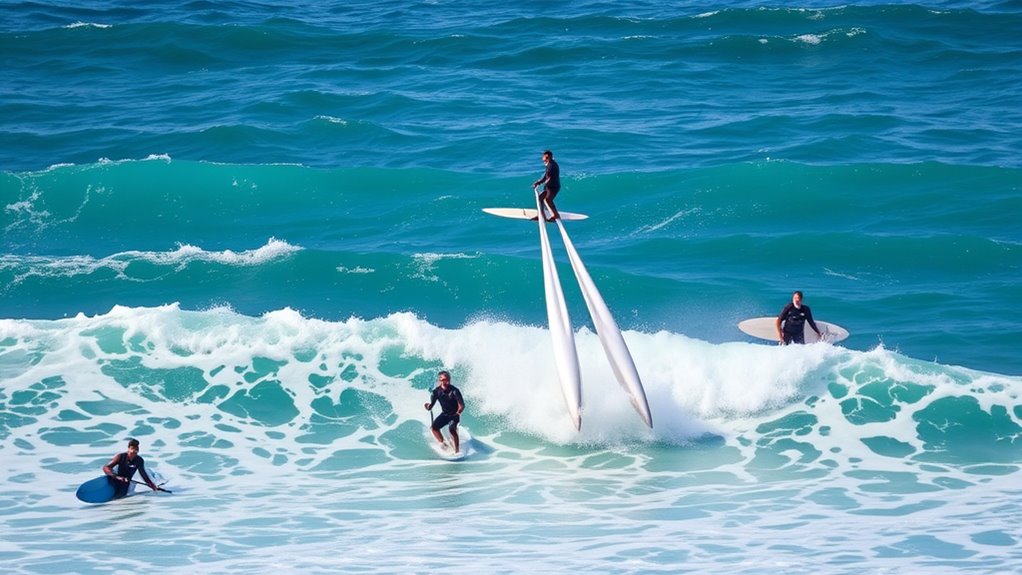
When comparing hydrofoiling to traditional surfing, you’ll notice differences in speed and maneuverability that can change how you ride waves. The learning curve for hydrofoiling might be steeper initially, but it offers new skills to master. Additionally, hydrofoil setups often require different equipment and come with higher costs, which can influence your choice. For those considering investment, understanding alternative investments like Gold IRA options can help diversify your portfolio outside of surfing gear and equipment costs. As the popularity of hydrofoiling continues to grow, staying informed about technological advancements can give you an edge in choosing the right gear and techniques. Incorporating cybersecurity measures to protect your equipment and personal data while exploring new surfing technologies can also be beneficial.
Speed and Maneuverability
Hydrofoiling offers a notable advantage in speed and maneuverability over traditional surfing. With a hydrofoil beneath your board, you can glide above the water at higher speeds, even on smaller or less powerful waves. This lift reduces drag, allowing for faster rides and more extended sessions. Maneuvering becomes more precise because the foil responds quickly to your shifts in weight and direction, giving you greater control. You can make tighter turns and carve more sharply than on a conventional surfboard. This increased agility enables you to explore different parts of the wave and execute advanced maneuvers more easily. Overall, hydrofoiling elevates your surfing experience by delivering faster speeds and more nimble control, opening new possibilities for riding waves.
Learning Curve Differences
While traditional surfing often requires years of practice to master balance, paddling, and wave reading, hydrofoiling presents a different set of challenges that can be easier to pick up initially. With hydrofoiling, you quickly learn how to lift onto the board and maintain stability on the foil, which often feels more intuitive than riding a traditional wave. Balancing on a hydrofoil involves focusing on subtle weight shifts and maintaining a steady stance, but it tends to be more forgiving for beginners. Paddling is simpler since you’re already positioned above the water, and catching waves can feel more accessible. Overall, the learning curve for hydrofoiling can be smoother at first, but mastering the nuances still requires practice and patience.
Equipment and Costs
Getting started with hydrofoiling typically involves higher upfront costs compared to traditional surfing. First, you’ll need a hydrofoil setup, which includes the board, foil, and mast—these can range from $1,500 to $3,000 or more. Second, you might want a dedicated electric pump or battery system if you’re using an e-foil, adding another $1,000 to $4,000. Third, consider accessories like wetsuits, protective gear, and storage racks, which can total $300 to $600. In contrast, traditional surfboards are often less expensive, usually between $500 and $1,000, with fewer specialized components. While hydrofoiling costs more upfront, it offers unique performance benefits that many surfers find worth the investment. Additionally, initial investment can help surfers access advanced features that enhance their riding experience, especially as they develop a better understanding of the holistic approaches to health and wellness associated with active lifestyles. Incorporating educational toys into training routines can also support skill development and safety awareness, making the learning curve smoother for beginners.
Essential Equipment for Hydrofoiling

To start hydrofoiling safely and effectively, you’ll need the right equipment. First, choose a hydrofoil board designed for beginners, which is usually smaller and more stable. The hydrofoil itself consists of a mast, wing(s), and fuselage; verify these are compatible and well-built for durability. A reliable wetsuit will keep you comfortable in the water, especially in cooler conditions. A leash is essential to prevent losing your board if you fall. Consider a wetsuit or impact vest for added safety and buoyancy. Finally, get a high-quality paddle if you’re using a stand-up hydrofoil, and always have fins or stabilizers properly attached. Having the right gear ensures a smoother learning curve and a safer, more enjoyable experience as you start hydrofoiling. Hydrofoil design plays a crucial role in your overall experience and performance on the water. Arcade machines, like those used for classic games such as Galaga, can sometimes be found at surf shops or recreational centers, adding an element of nostalgia to your water sports experience. Additionally, understanding hydrofoil materials can help you select equipment that balances weight, strength, and performance for your skill level.
A thorough understanding of AI safety can also inform your approach to choosing durable and reliable equipment, ensuring longevity and safety during your sessions.
Basic Skills and Techniques to Get Started
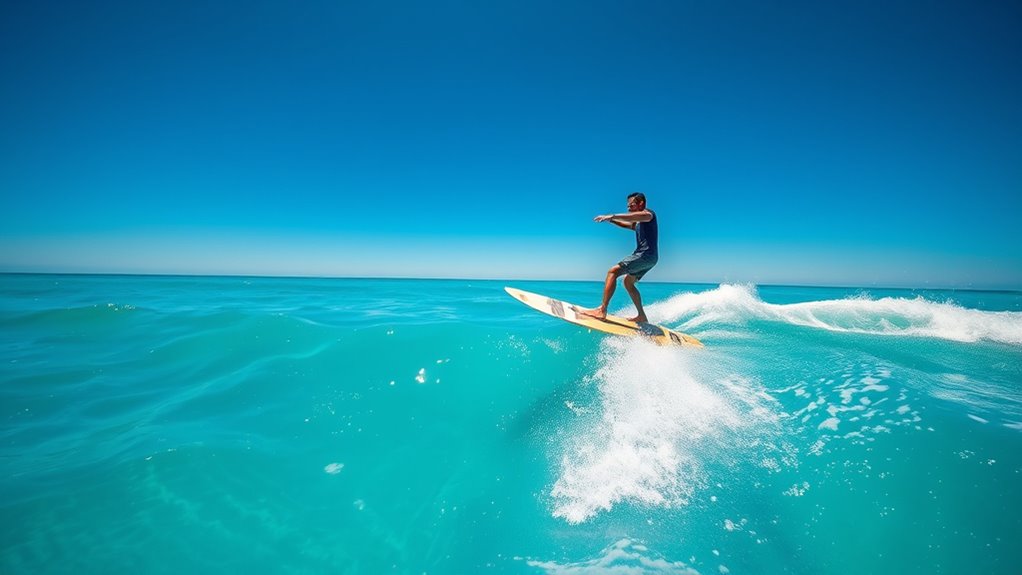
Before you can confidently ride a hydrofoil, you need to master some basic skills and techniques. First, practice balancing on your board without a foil, focusing on your stance and weight distribution. Second, learn to control your speed by gently accelerating and decelerating, which helps you stay steady on the water. Third, work on your paddle and pop-up skills to quickly get into a standing position once you’re ready to foil. These foundational skills build your confidence and control, making your progression onto the hydrofoil smoother. Additionally, understanding industry trends can help you stay informed about the latest equipment and techniques, enhancing your learning process. Being aware of privacy and cookie policies ensures a safer online experience while researching new gear. Recognizing the importance of quality assurance in equipment selection can also contribute to safer and more successful sessions. Staying updated on new technological developments can give you an edge as you advance in hydrofoiling. Incorporating knowledge of essential oils for respiratory health might seem unrelated, but maintaining clear breathing can improve your overall watercraft control and endurance. Remember, patience and consistent practice are key to mastering these techniques. Once you’re comfortable with these basics, you’ll set yourself up for a successful and enjoyable hydrofoiling experience.
Tips for Safe and Enjoyable Hydrofoiling
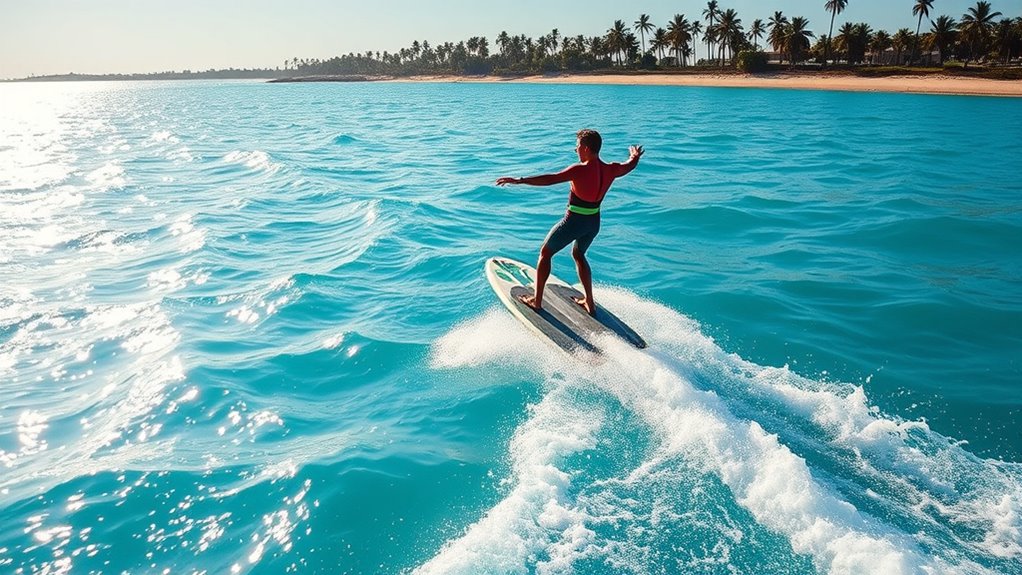
To enjoy hydrofoiling safely, always wear proper safety gear like a helmet and impact vest. Stick to calm waters until you’re confident with your control and maneuvers. Practice controlled movements to build skill and reduce the risk of accidents. Additionally, being aware of environmental considerations can help you minimize your impact on the natural surroundings. Being mindful of sound healing science can also promote mental focus and relaxation during your session. Staying informed about market volatility and current conditions can further enhance your safety and enjoyment. Incorporating body awareness techniques from somatic therapy can also help you stay present and responsive during your session.
Wear Proper Safety Gear
Wearing proper safety gear is essential for ensuring a safe and enjoyable hydrofoiling experience. It helps protect you from injuries and boosts your confidence on the water. First, always wear a well-fitting helmet to shield your head from falls or collisions. Second, use a impact vest or personal flotation device (PFD) to keep you buoyant and protect your torso. Third, consider wearing wetsuit gloves and booties for added grip and protection against sharp objects or cold water. Additionally, check that your gear is in good condition before each session. Proper safety gear minimizes risks, allowing you to focus on mastering your skills and enjoying the ride. Remember, safety gear is your first line of defense in hydrofoiling.
Practice in Calm Waters
Practicing in calm waters is the best way to build your confidence and develop your hydrofoiling skills safely. Choose a shallow, smooth spot away from busy surf zones to minimize risks. Start by getting comfortable on your board, practicing balanced standing and gentle movements. Focus on maintaining a steady stance and controlling your speed with your hydrofoil’s throttle. Keep your arms relaxed and your body centered to stay balanced. Avoid sudden turns or aggressive maneuvers until you’re more experienced. Use a safety leash to prevent losing your board. Take your time, and don’t rush the process. As you grow more confident, gradually explore more challenging conditions. Calm waters provide the perfect environment to learn the basics without feeling overwhelmed.
Learn Controlled Maneuvers
Once you’re comfortable riding in calm waters, focus on mastering controlled maneuvers to enhance safety and enjoyment. Practice these key skills:
- Turning smoothly – Shift your weight gradually to steer the board, keeping control and avoiding abrupt movements.
- Adjusting height – Learn to subtly shift your weight to raise or lower the hydrofoil, helping you navigate different water conditions.
- Emergency dismounts – Practice safely getting off the board if you lose balance, reducing the risk of injury and building confidence.
Consistent practice of these maneuvers improves your control and helps you react quickly to changing conditions. Stay relaxed, focus on your movements, and always prioritize safety to make hydrofoiling both fun and secure.
Choosing the Right Conditions and Locations
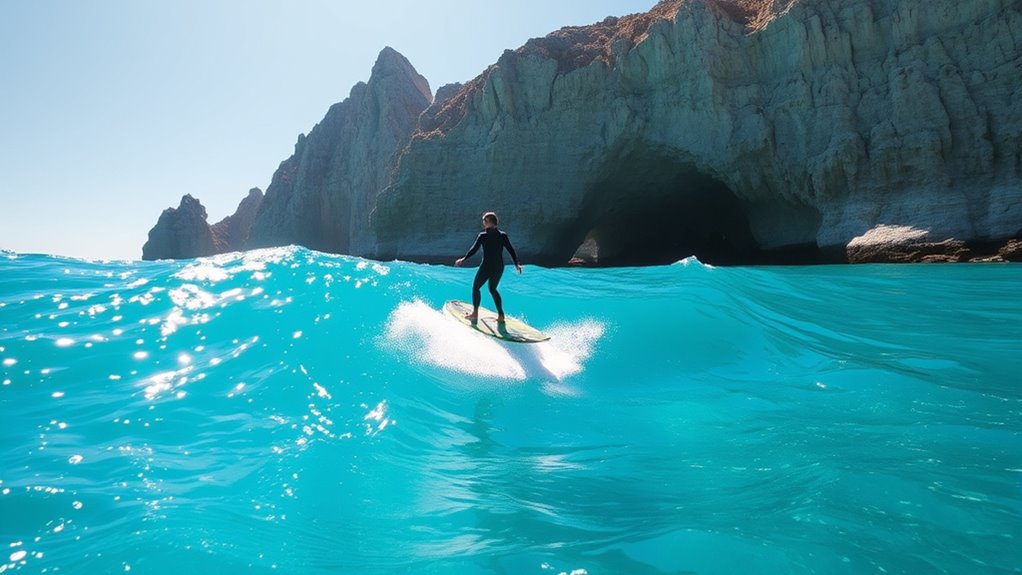
Choosing the right conditions and locations is essential for a successful hydrofoiling experience. Look for clean, open waters with minimal crowds to avoid collisions and distractions. Ideal conditions include steady, moderate waves or swell, which provide lift and stability without overwhelming you. Calm winds are preferable, as strong gusts can make control difficult. Coastal spots with consistent surf are best, especially those with shallow, sandy bottoms that reduce risk during falls. Check local reports to find days with favorable tides and minimal current. Avoid crowded or rocky areas, and always consider safety—select spots where rescue options are accessible. By choosing the right environment, you’ll build confidence and enjoy smoother, more enjoyable sessions.
Progressing in Hydrofoiling and Advanced Tricks
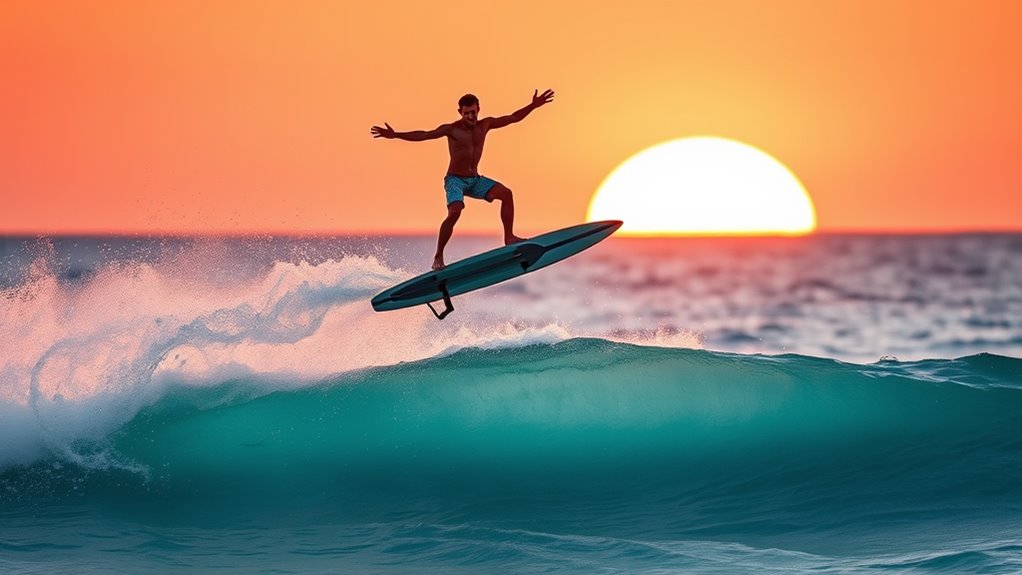
After mastering the basics of hydrofoiling and feeling comfortable in steady conditions, you can start exploring more advanced tricks to elevate your skills. Push your limits by trying these steps:
- Jumps and Pop-Ups: Practice small jumps to get comfortable lifting off the water, then progress to higher pop-ups to gain air awareness.
- Carving and Turns: Focus on sharp, fluid turns to improve control and style, using your hips and shoulders to guide the board.
- Wave Riding and Pumping: Ride breaking waves or perform pumping motions along the face to generate speed and stay ahead of the swell.
Consistent practice and patience will help you master these tricks, accessing new levels of fun and performance on your hydrofoil.
Frequently Asked Questions
How Long Does It Take to Become Proficient in Hydrofoiling?
You might wonder how long it takes to become proficient in hydrofoiling. Usually, with consistent practice, most surfers gain confidence and skill within a few sessions, around 5 to 10. However, mastering advanced maneuvers can take several months. The key is to stay patient, practice regularly, and focus on fundamentals. Everyone learns at different speeds, so don’t get discouraged—progress comes with time and persistence.
Can I Hydrofoil on Any Type of Surfboard?
You can hydrofoil on many types of surfboards, but not all are ideal. Shortboards, longboards, and specially designed foil boards work best because they offer the right volume and shape for stability and control. Using a regular surfboard might make hydrofoiling more difficult, especially if it’s too narrow or lacks enough buoyancy. So, choose a board suited for foiling to make your experience smoother and safer.
What Are the Common Injuries Associated With Hydrofoiling?
You should be aware that hydrofoiling can lead to injuries like cuts, bruises, and fractures if you fall or collide with the foil or board. Wrist, ankle, and knee sprains are common from awkward landings or sudden stops. Additionally, you might experience back or neck strain from improper posture or falls. Always wear protective gear and practice in safe conditions to minimize these risks.
Is Hydrofoiling Suitable for Children and Beginners?
Hydrofoiling can be suitable for children and beginners, but safety and proper instruction are essential. You should start with beginner lessons on stable equipment and in calm waters. Kids and newbies need to learn balance and control gradually. Always wear safety gear, stay within your skill level, and practice under supervision. With patience and proper guidance, hydrofoiling can be an exciting activity for children and beginners alike.
How Does Wind Influence Hydrofoiling Performance?
Wind can dramatically impact your hydrofoiling performance, feeling like a wild beast fighting to control your ride. When the wind picks up, it creates choppy waters and unpredictable gusts, making your ride rough and challenging. Light winds offer smoother, more stable conditions, allowing you to glide effortlessly. Strong winds demand skillful handling and can cause instability, so always check wind conditions before heading out to make certain of a safer, more enjoyable experience.
Conclusion
Hydrofoiling opens up a whole new world of surfing, like discovering a hidden treasure beneath the waves. With patience and practice, you’ll find yourself gliding smoothly above the water, feeling more connected and free. Remember, every new skill takes time—think of it as planting a seed that will grow into something extraordinary. Keep pushing your limits, stay safe, and enjoy the ride. Before you know it, hydrofoiling will become your new favorite way to surf.










